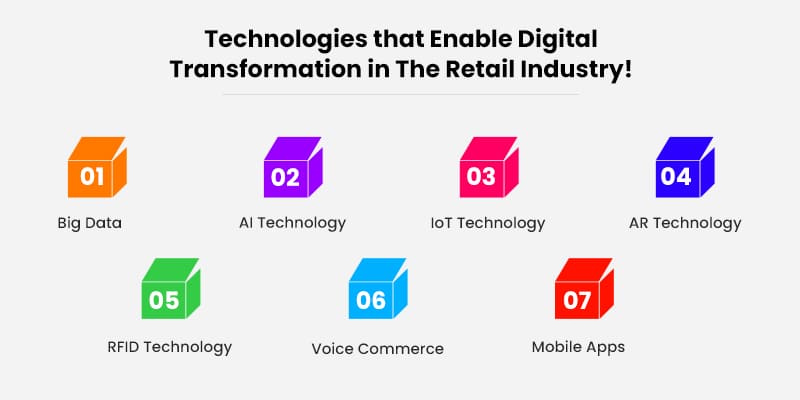
When it comes to business, things have changed dramatically in today’s world. A substantial role is played by digitalization. Digital business transformation aids in the development of strategies that change the culture and improve the customer experience.
The same may be said about digital transformation in the retail sector. Retailers will reassess how they leverage technology to generate new revenue streams and create novel business strategies. As a result, as technology and digital tools advance, they will have a significant impact not only on the company’s products or services but also on its internal culture, leadership, and workflow architecture.
But, what exactly is digital transformation? Why is it so beneficial for retail businesses?
Today, through this blog, we’re going to answer these questions and will provide a lot of information on digital transformation in the retail sector.
What is Digital Transformation?
Digitalization is the transformation of business processes. Businesses can incorporate digital technology to streamline business operations, increase firm efficiency, and enhance customer experience. Organizations must upgrade their systems, processes, organization, and culture to achieve this goal.
But,
Why is Digital Transformation Important for The Retail Industry?
The retail environment is more challenging than it has ever been. Without a doubt, a digital transformation is no longer an option for retailers; it is now a need to stay in business. The values of today’s purchasers – ease, environmental friendliness, and so on – necessitate a more personalized experience. To gather information, they make extensive use of digital technologies and a variety of channels. Consumption is rising in general, but the pathway to purchase for consumers is becoming more multi-channel. As a result, improvements in retail are necessary.
You won’t believe, as per the research by Statista, the global retail market generated almost 25 trillion dollars in sales in 2019 and is predicted to hit nearly 27 trillion dollars by 2022.
Huge, isn’t it?
With the aid of digital transformation solutions, it is possible to maximize the productivity of operating activities, lowering the cost of goods and making them more accessible on the market.
Also Read- Top Digital Transformation Trends For Your Business
At the very same time, many retailers observe that most customers are enthused about technological advancements and willing to use them in stores. A store can use digital technologies to collect customer data, track buying patterns, assess demand, and attract new customers.
But,
Benefits of Digitalization in The Retail Industry!
Every retailer, like any other business, aspires to meet two primary objectives: more earnings and lower costs. As a result, most retailers place a premium on engaging with customers, as this is the area that has the most effect on profitability. In retail shop chains, digital transformation allows them to streamline business operations and gather more necessary data, allowing them to make more reasonable and rational choices and maintain a competitive edge.
Below are some of the benefits of digital transformation in the retail industry:

Ensures Better Customer Support
Retailers in the new age can no longer have to pay to be reactionary. They must take the initiative to ensure that traditional and electronic channels are seamlessly integrated. More and more retailers are embracing a linked approach in which all touchpoints are used to help customers at the same time. At each stage of the digital maturity model, social, internet, mobile, and IVR all work together to develop an enduring rapport with customers. Furthermore, digital monitoring devices provide critical inputs as well as 24/7 access to customer activities, interactions, and social activities. As a result of the digital transformation solutions in the retail sector, the CRM solutions retail industry is becoming more and more competitive.
Ensures more Connections and Easy Operations
Retailers and their consumers can connect and communicate more easily through social networks, websites, bots, and mobile apps as a result of digital transformation. Aside from that, implementing cloud technology will improve internal as well as external processes, reducing the time spent sharing customer data and increasing customer service.
Ensures Easy Procurement
Order sourcing and fulfillment are key operations that define a retailer’s success. The use of a digital retail system allows for the precise monitoring of such procedures. The Internet of Things (IoT) and Blockchain are giving real-time data to improve procurement. Several disruptive technologies, including artificial intelligence (AI), virtual reality (VR), and cyber tracking, are improving strategic sourcing accuracy. These technologies will enable businesses to acquire useful information about consumer ratings, social attitudes, and the client wants across channels. As most merchants want to cater to individual needs, category managers are turning to digital tools to better identify new market trends and create more specialized assortments.
Improves Inventory Management
Smart shelves may detect when there are fewer goods on the shelves or when objects are not properly arranged on a shelf.
In addition, chances of in-store theft and items laying on the floor can be reduced. Products can be placed in the right areas using deep learning (by identifying consumer data and behavior. In-store experience) so that customers don’t have to search for a product. Additionally, better inventory management can be accomplished, as well as having the appropriate product available in the store.
What are The New Trends and Technologies that Enable Digital Transformation in The Retail Industry!
Top trends and technologies are:

Big Data
In retail, big data plays an essential role and is extensively used. Big data forecasts demand, streamlines pricing and functions of an organization, and reconfigures your offer to stay ahead of the consumer and satisfy their requirements and wants because it provides insights into customer behavior and also helps predict trends.
Also Read- Big Data Analytics: Unlocking Industry-Specific Solutions for Transformative Business Insights
AI Technology
AI technology facilitates online purchasing and pushes products based on client behavior, aids in making customer service quicker and more efficient.
Customers’ question response times have been drastically lowered as a result of the widespread adoption of chatbots, keeping them content and happy. Retailers’ capacity to provide fast and tailored service to customers has improved as a result of AI use, resulting in increased customer satisfaction and deeper customer commitment. Furthermore, AI-based inventory management systems can assist you in better managing these inventories through a variety of approaches.
IoT Technology
Retailers are making sensible measures to strengthen their marketing and sales tactics.
Automation, smart shelves, computerized checkouts, and layout optimizations are all examples of smart technology that are becoming more popular in stores. All of these things improve customer service, sales, customer satisfaction, and inventory management.
AR Technology
In the digitization of services, augmented reality (AR) is a fantastic tool that allows customers to try things out without having to leave their homes
For example, many companies managed to come up with the brilliant idea of allowing customers to use their app to select the greatest pieces of furniture. Simply position a camera in the appropriate location at home, and the app will present you with options that match your decor. Workers could also use augmented reality to address any issues with a shelf. A worker might place their device’s camera up to a shelf to uncover areas for improvement using AR and AI-based object detection technology. AR representation can indicate the worker where areas of the shelf do not line with the planogram and need to be rectified by comparing the shelf with its matching planogram. This could include objects that are out of place, items that are improperly zoned, and even the detection of broken products.
RFID Technology
RFID technology, which is used to track down things in retail stores, is useful but has a limited range. As these technologies advance, IPS will be able to provide more specific information on product locations on the sales floor. This could also help not just to strengthen asset protection measures but also to make things easier to return relocated things to their proper locations. Retail staff can employ their work devices to locate areas in the store employing IPS maps for duties such as order fulfillment. They could alternatively navigate to the item if it has IPS tracking enabled. This would be handy if the item was accidentally moved from its original place.
Voice Commerce
Voice commands and responsiveness of virtual assistants like Siri, Google Assistant, and Alexa are improving all the time. In the retail industry, their capacity to assist clients has vastly enhanced. The process of ordering things from home using your voice, with or without a screen to aid you visually, has a lot of nuances to be explored.
By 2025, smart home gadgets are estimated to be utilized in more than 77 million households in the United States, presenting significant business potential.
Mobile Apps
A smartphone app is an excellent link between the customer and the physical store. Customers may look at the products, watch videos, and read reviews, among other things. They can also quickly contact the support group if they have any questions.
If you don’t already have a mobile app for your store, you should think about it because it offers a lot of benefits, makes the purchase easier, and puts you connected to your consumers. Additionally, mobile apps are a good place to start for further development because they allow you to add new features and improve the services you offer.
Conclusion
By properly understanding the changing customer behavior, digital transformation solutions help to maintain retail businesses. As a retailer, developing a digital maturity model to lead your company through every phase of your customer’s experience is critical. In many ways, digital transformation in the retail sector has already begun, and some businesses have already reaped the benefits of their efforts. Still, now that we are aware of the benefits and trends of digital transformation solutions, it is time for you to leverage digital transformation solutions in your retail business and provide customers with exclusivity.
Contact a leading app development company like Matellio if you want to take advantage of the benefits of digital transformation for your retail business.
Speak with one of our professionals to learn more about the area and how your company may profit from it right away.




